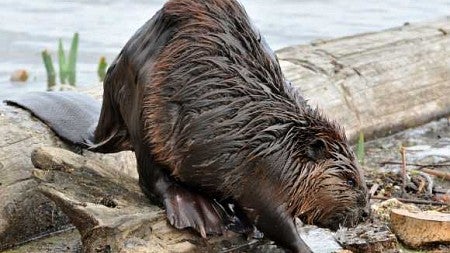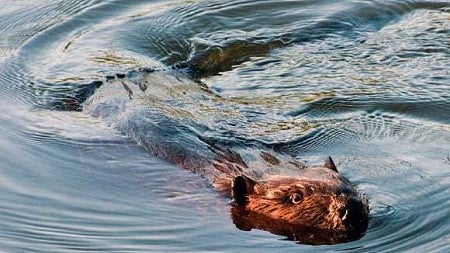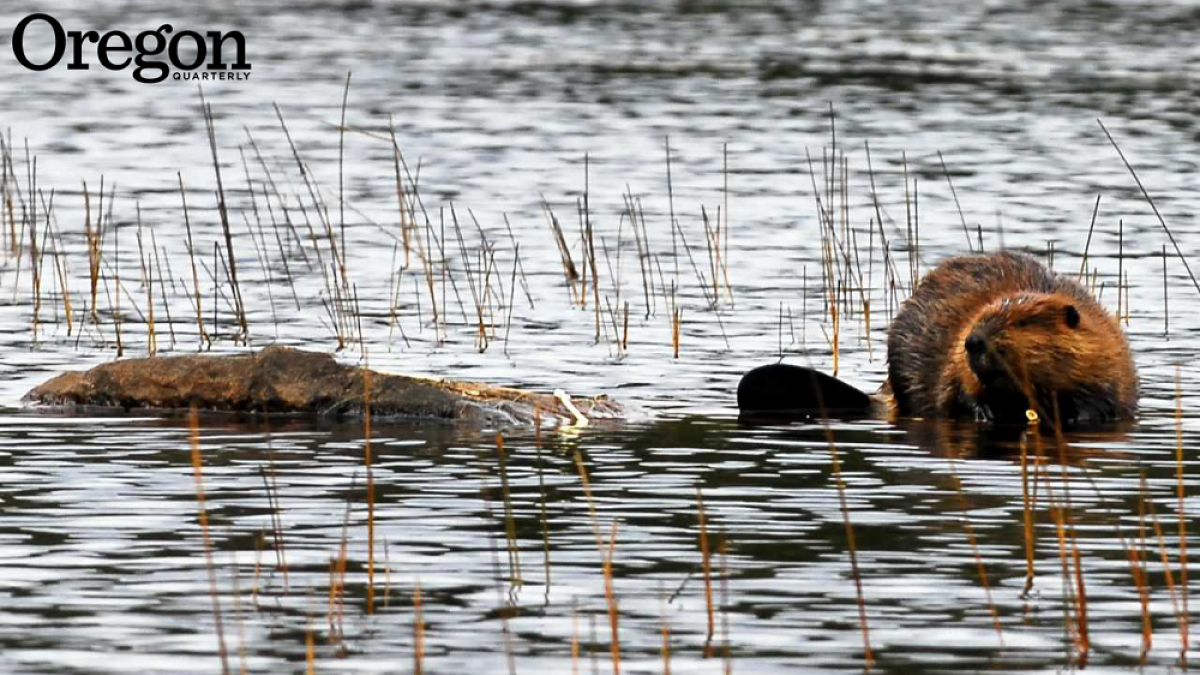Marine biology majors don’t typically go looking for thesis topics up freshwater streams, but that’s where Clark Honors College graduate Allison Cramer ’10 found hers: hip-deep in Anderson Creek, above Coos Bay’s South Slough. She was spending the summer at the Oregon Institute of Marine Biology, fishing for a project and hoping for something cool—something requiring original research and fieldwork. So she went to talk with Craig Cornu, stewardship coordinator at neighboring South Slough National Estuarine Research Reserve. No problem, Cornu said; he had plenty of salmon-related projects she could do on the reserve.
His next question: “Are you interested in beavers?”
Not break-dancing, bipedal Benny Beaver from Corvallis, but the large semiaquatic rodent, Castor canadensis, Oregon’s state animal. You’ve seen it, if only on the back of the state flag, in placid profile hunched on a downed tree branch, textured tail askew for full effect, proudly displaying those signature buckteeth. In the mid-1920s, after the state adopted its current flag design, there were almost as many beavers on flags as there were in the wild. They’re still a rare sight, shy nocturnal creatures that they are. But beavers are back, building dams and creating wetlands on rivers and streams from the coast to the inland ranges, even in urban areas. Perhaps you’ve thrilled to the sudden slap of that flat tail on water as you canoed a quiet stretch of river. Maybe you’ve cussed when you found your culvert blocked by the efforts of this persistent, iconically hard-working mammal.
If you’re not yet well-acquainted with beavers, that may change. Trapped nearly to extinction in the early nineteenth century, denied habitat by farmers and timber companies and all the rest of us, beavers are garnering new respect, in Oregon and around the world—just in time, scientists say, to help save us from ourselves, if we’ll only let them.
Interested in beavers? It’s not that Cramer was uninterested, but with her marine science focus, she’d simply never thought much about them. A few minutes into her conversation with Cornu, however, Cramer began to understand why he had mentioned salmon and beavers in practically the same breath. Many of the streams feeding South Slough had been diked and their naturally meandering courses straightened a century ago by farmers claiming tidelands for pasture, he explained. That process made those streams inhospitable to salmon. In 2001, the reserve had removed the dikes at Anderson Creek and rerouted it to restore its curves. Ultimately, the goal was to bring back the stream’s complexity, so that it no longer merely flushed water but let it linger, encouraging a rich variety of plant and animal life to take hold. Willows were planted in hopes of luring beavers—nature’s own wetlands engineers—to set up housekeeping, build dams, and finish the job. By 2002, beavers had come back and, within a few years, had turned the creek’s final quarter-mile into a series of stair-stepped ponds brimming with life. Just how many beavers were working the creek by 2007, Cornu didn’t know; he was hoping Cramer could craft a project to find out.
Such a study would be one more piece in a growing body of research exploring beavers’ key role in the ecosystem. Swimming, crawling, and flying creatures of all kinds depend upon wetlands, including roughly half of all threatened and endangered plant and animal species. Cue the beaver: Simply stated, creating and maintaining wetlands is what beavers do. They do it for their own benefit (to create cover from predators and to more easily transport their favorite foodstuffs), but the rewards fan out far across the landscape. Waterfowl—ducks, for instance—and fish are especially beholden to beaver-built wetlands, none more than the coastal coho, which is listed as a threatened species in Oregon.

Only one species approaches Homo sapiens in its ability and inclination to alter the landscape, and that’s the beaver. And when scientists count the number of young salmon in beaver-engineered wetlands versus human-restored wetlands, there’s no contest: Beaver ponds typically contain twenty, fifty, even one hundred times the number of young salmon compared to those found in even the most meticulously reengineered stream. And beavers work cheap. All they need is a supply of building materials and a food source—a healthy stand of willows or alders or cottonwoods works well. Not that humans can’t help; a few well-placed rocks or roots can provide the footing a pair of beavers needs to start its work. But the numbers are clear; in the contest for who can best lure coho salmon back to Oregon’s coastal streams, it’s beavers: game, set, match.
Which is why, when he returned to Gearhart last fall after four years at the UO and two years as a county planner in Montana, Jon Wickersham ’08 was happy to see signs of beaver activity everywhere: streamside willow stumps gnawed to sharp points, dams of sticks and mud blocking creeks, ponds brimming with plants and insects and birds and mammals—wildlife of all kinds. His first week as conservation director of the North Coast Land Conservancy was a crash course in the contributions beavers make toward helping the land trust achieve its goals. “In terms of habitat restoration work, beavers can do it ten times better than we can,” Wickersham notes. “They play a big role in a lot of our conservation projects.”
Jeff Rodgers ’78 is another Duck-turned-beaver believer. For the twenty-four years prior to his becoming a monitoring coordinator for the Oregon Plan for Salmon and Watersheds in 2003—specifically focused on restoration of Oregon coastal salmon and steelhead runs—he lived in a wetsuit every August and September, snorkeling Oregon’s coastal streams and counting salmon for the Oregon Department of Fish and Wildlife. Flicking on a flashlight during the occasional night-time snorkel, he was sometimes startled to see a beaver looming in the dark water. Startled, and pleased.
“To reach our conservation recovery goals for coho salmon,” Rodgers says, “we need a lot of the habitat that beavers provide. And you can’t get there just by putting wood in the streams.” In fact, says Rodgers, it may be impossible for Oregon’s coho runs to recover to desired levels without help from beavers.
Naturally, there’s a catch. Beavers are easy to love when it’s not your fruit trees they’re cutting down, your culvert their dam is blocking, your pasture they’re flooding. And there’s still a sizable contingent of Oregonians who enjoy fur trapping for fun. Trappers need only buy a permit from ODFW, like a fishing license, to bag a beaver on public land. Owners of private land—from hobby farms to huge timber holdings—are allowed to kill any beaver they find annoying on their property, no permit, no questions asked. That’s put ODFW in the awkward position of being the agency that is both regulating the legal killing of beavers and encouraging the proliferation of beavers for salmons’ sake. “We’re caught between a rock and a hard place,” Rodgers admits. “We know that beavers are extremely valuable in providing ecological benefits to fish and other wildlife. At the same time, it’s also a fact that beavers can do a lot of property damage.”
There are alternatives to lethal control. Wire cages around trees can limit beavers’ damage, as can “beaver deceiver” devices installed to protect culverts. Live-trapping and moving beavers (allowed by permit) is an option, but like killing them, it’s not an ideal—or even permanent—solution. Displaced beavers tend to get hit by cars or killed by cougars. And if the habitat is good, count on another beaver arriving soon to replace the dead or relocated one.
In an attempt to reconcile these conflicting agendas, ODFW in 2007 convened the Beaver Workgroup. It began as a way for staff members from both sides of ODFW—wildlife and fish—to talk. In the process, it has helped break down the virtual “firewall” that had long existed between the two camps, Rodgers says. The workgroup has since welcomed a broader spectrum of stakeholders: other state and federal agencies, trappers, timber companies, conservation groups, and watershed councils. Among the options they’ve been exploring: making payments to landowners to cover damages resulting from living with, rather than killing, a “problem” beaver, not unlike payments made to ranchers in the Rockies to compensate them for livestock killed as a result of wolf reintroduction. By spring 2011 the workgroup hopes to have the results of a survey it commissioned of Oregon landowners. The survey’s central question: What would it take—in dollars—to adopt a live-and-let-live stance toward beavers on your land? As Rodgers puts it, “A lot of the money we spend on sticks and stones”—mechanical stream restoration—“might be better spent on incentives to allow beavers to do their thing.”

Many of the streams in her district have been heavily damaged over the years by placer mining, grazing, logging, and road building. Grazing by deer and elk as well as livestock continues to damage streams. “In some places, beavers are the only way we are going to be able to restore good stream function,” she says. The major limiting factor is habitat. Even if you move the cattle away from streams, elk will still cluster there, nipping streamside willows and aspens to the point where there’s nothing left for beavers to eat or build with. The obvious solution—witnessed in Yellowstone National Park—is reintroduction of wolves, which keep nervous elk on the move, resulting in a huge improvement in riparian habitat. It also introduces a whole new set of challenges, Fouty acknowledges, and underscores the complexity of restoration efforts. “For so long, we have taken and taken and expected that the resources would just give and give,” she says. “Learning to share with wildlife represents a whole new approach.
“It requires a massive paradigm shift, by ODFW and federal land management agencies and the public, and everything takes a long time,” Fouty adds. “The sooner we get started, the better. If we don’t get this piece fixed, then all of northeastern Oregon becomes more and more sensitive to climate change.”
That same sense of urgency can be found in western Oregon, where coastal salmon runs have been dwindling. How many beavers were there on Anderson Creek? Cramer has no idea. Her plan was to photograph the shy rodents remotely, using “camera traps” triggered by infrared sensors rather than live-trapping them or making vague estimates based on evidence of their activity. Despite the technique’s success with other species, it fell flat with the wily beavers.
Not to say the project wasn’t a success. Cramer shifted to a major in general biology with a double emphasis on marine biology and on ecology and evolution. And she is applying to graduate school, where she intends to study behavioral ecology and its application to wildlife management. It’s a career direction that she says was “100 percent” inspired by her acquaintance with the beavers on Anderson Creek. Ultimately, for humans grappling with climate change and species extinction, a more nuanced view of the natural world that is emerging from scientists’ close study of beavers is proving far more valuable than any number of beaver felt hats.
“It’s an ecosystem thing,” Rodgers says. “There are a lot of things wrong. A lot of things have unraveled that we need to put back together. The question is, if we kick-start it’’—by providing the habitat beavers need, then not killing them when they show up—“can we let beavers do it, so we can go on and do other things?”
—By Bonnie Henderson
Bonnie Henderson ’79, MA ’85, a Eugene writer, is the author of Strand: An Odyssey of Pacific Ocean Debris, a finalist for the Oregon Book Awards in 2009.


